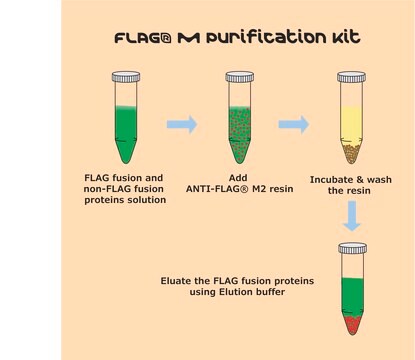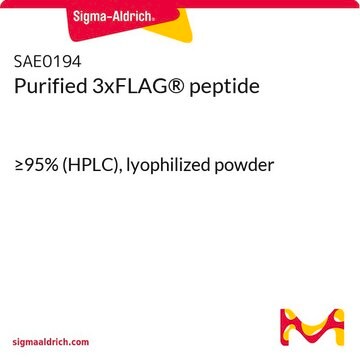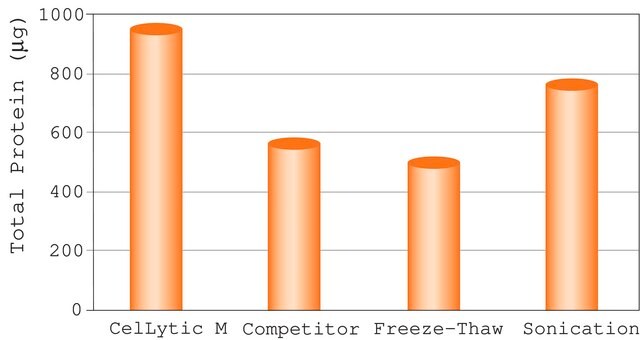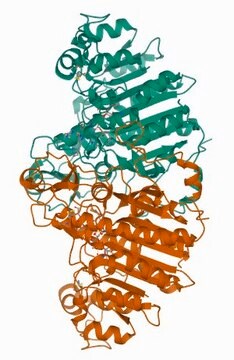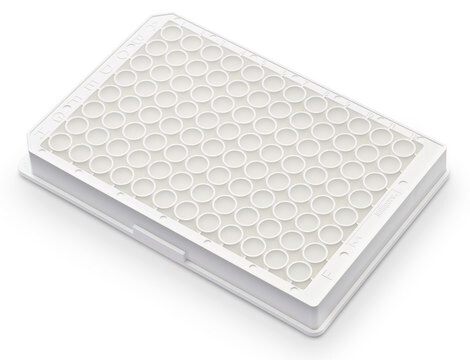FLAGIPT1
FLAG® Immunoprecipitation Kit
Synonym(s):
Anti-ddddk, Anti-dykddddk
Sign Into View Organizational & Contract Pricing
All Photos(1)
About This Item
UNSPSC Code:
12352200
NACRES:
NA.32
Recommended Products
usage
kit sufficient for 50 reactions
Quality Level
analyte chemical class(es)
proteins (FLAG® Affinity Gels)
technique(s)
immunoprecipitation (IP): suitable
shipped in
wet ice
storage temp.
−20°C
General description
Sigma′s FLAG Immunoprecipitation kit allows a rapid and efficient immunoprecipitation and elution of an active FLAG-tagged protein. The immunoprecipitation is performed with the ANTI-FLAG M2 affinity gel, which is a highly specific monoclonal antibody covalently attached to agarose resin. The use of affinity resin allows an efficient binding of FLAG-tagged proteins without the need for preliminary steps and calibrations. The immunoprecipitated FLAG-tagged proteins can be efficiently eluted from the resin with acidic conditions or by competition with FLAG peptide. The immunoprecipitated proteins can be detected for their size, post-translational modifications, and interactions on gel electrophoresis, and by activity assays.
Application
Learn more product details in our FLAG® application portal.
Features and Benefits
- Utilizes highly specific ANTI-FLAG M2 affinity gel
- No preliminary steps or calibrations
- 3X FLAG™ peptide provides efficient and gentle elution through direct competition
Other Notes
All prodedures to be performed at 2-8°C.
Legal Information
3xFLAG is a trademark of Sigma-Aldrich Co. LLC
FLAG is a registered trademark of Merck KGaA, Darmstadt, Germany
related product
Product No.
Description
Pricing
Signal Word
Warning
Hazard Statements
Precautionary Statements
Hazard Classifications
Aquatic Chronic 3 - Eye Irrit. 2
Storage Class Code
10 - Combustible liquids
Choose from one of the most recent versions:
Already Own This Product?
Find documentation for the products that you have recently purchased in the Document Library.
Mercedes Rodriguez-Teja et al.
Molecular cancer research : MCR, 13(3), 538-547 (2014-11-09)
Epithelial cell-cell contacts maintain normal glandular tissue homeostasis, and their breakage can trigger epithelial-to-mesenchymal transition (EMT), a fundamental step in the development of metastatic cancer. Despite the ability of C-type lectin domains (CTLD) to modulate cell-cell adhesion, it is not
Xiao Zhang et al.
JCI insight, 5(16) (2020-07-21)
The regulatory mechanisms enabling the intestinal epithelium to maintain a high degree of regenerative capacity during mucosal injury remain unclear. Ex vivo survival and clonogenicity of intestinal stem cells (ISCs) strictly required growth response mediated by cell division control 42
Konstantinos Koudounas et al.
Plant physiology, 174(3), 1371-1383 (2017-05-10)
Oleuropein, a terpene-derived glycosylated secoiridoid biosynthesized exclusively by members of the Oleaceae family, is involved in a two-component defense system comprising a β-glucosidase that activates oleuropein into a toxic glutaraldehyde-like structure. Oleuropein and its deglycosylated derivatives have high pharmaceutical interest.
Andrew S Terker et al.
American journal of physiology. Renal physiology, 315(4), F781-F790 (2018-02-08)
With no lysine kinase 4 (WNK4) is essential to activate the thiazide-sensitive NaCl cotransporter (NCC) along the distal convoluted tubule, an effect central to the phenotype of familial hyperkalemic hypertension. Although effects on potassium and sodium channels along the connecting
Mateusz Wydro et al.
Nucleic acids research, 38(11), 3732-3742 (2010-02-11)
Mammalian mitochondria contain their own genome that is almost fully transcribed from both strands, generating polycistronic RNA units that are processed and matured. The mitochondrial mRNA is modified by oligo- or polyadenylation at the 3' termini, but the exact function
Our team of scientists has experience in all areas of research including Life Science, Material Science, Chemical Synthesis, Chromatography, Analytical and many others.
Contact Technical Service
